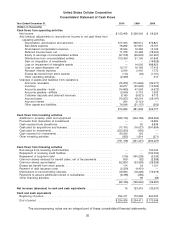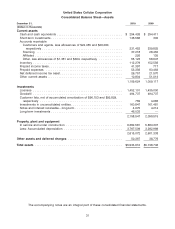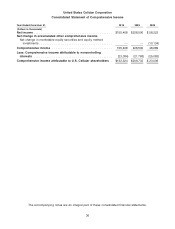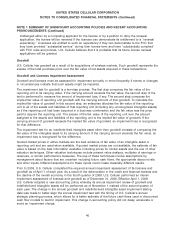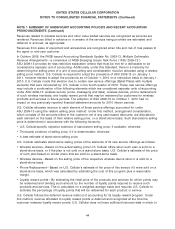US Cellular 2010 Annual Report Download - page 47
Download and view the complete annual report
Please find page 47 of the 2010 US Cellular annual report below. You can navigate through the pages in the report by either clicking on the pages listed below, or by using the keyword search tool below to find specific information within the annual report.
UNITED STATES CELLULAR CORPORATION
NOTES TO CONSOLIDATED FINANCIAL STATEMENTS (Continued)
NOTE 1 SUMMARY OF SIGNIFICANT ACCOUNTING POLICIES AND RECENT ACCOUNTING
PRONOUNCEMENTS (Continued)
The allowance for doubtful accounts is the best estimate of the amount of probable credit losses related
to existing accounts receivable. The allowance is estimated based on historical experience and other
factors that could affect collectability. Accounts receivable balances are reviewed on either an aggregate
or individual basis for collectability depending on the type of receivable. When it is probable that an
account balance will not be collected, the account balance is charged against the allowance for doubtful
accounts. U.S. Cellular does not have any off-balance sheet credit exposure related to its customers.
The changes in the allowance for doubtful accounts during the years ended December 31, 2010, 2009
and 2008 were as follows:
(Dollars in thousands) 2010 2009 2008
Beginning balance ................................ $26,624 $ 8,372 $ 12,723
Additions, net of recoveries ........................ 76,292 107,991 73,157
Deductions .................................... (77,100) (89,739) (77,508)
Ending balance .................................. $25,816 $ 26,624 $ 8,372
Inventory
Inventory primarily consists of wireless devices stated at the lower of cost or market, with cost
determined using the first-in, first-out method and market determined by replacement costs or estimated
net realizable value.
Fair Value Measurements
Under the provisions of GAAP, fair value is a market-based measurement and not an entity-specific
measurement, based on an exchange transaction in which the entity sells an asset or transfers a liability
(exit price). The provisions also establish a fair value hierarchy that contains three levels for inputs used
in fair value measurements. Level 1 inputs include quoted market prices for identical assets or liabilities
in active markets. Level 2 inputs include quoted market prices for similar assets and liabilities in active
markets or quoted market prices for identical assets and liabilities in inactive markets. Level 3 inputs are
unobservable.
Licenses
Licenses consist of costs incurred in acquiring Federal Communications Commission (‘‘FCC’’) licenses to
provide wireless service. These costs include amounts paid to license applicants and owners of interests
in entities awarded licenses and all direct and incremental costs related to acquiring the licenses.
U.S. Cellular has determined that wireless licenses are indefinite-lived intangible assets and, therefore,
not subject to amortization based on the following factors:
• Radio spectrum is not a depleting asset.
• The ability to use radio spectrum is not limited to any one technology.
• U.S. Cellular and its consolidated subsidiaries are licensed to use radio spectrum through the FCC
licensing process, which enables licensees to utilize specified portions of the spectrum for the
provision of wireless service.
• U.S. Cellular and its consolidated subsidiaries are required to renew their FCC licenses every ten years
or, in some cases, every fifteen years. To date, all of U.S. Cellular’s license renewal applications have
been granted by the FCC. Generally, license renewal applications filed by licensees otherwise in
compliance with FCC regulations are routinely granted. If, however, a license renewal application is
39



